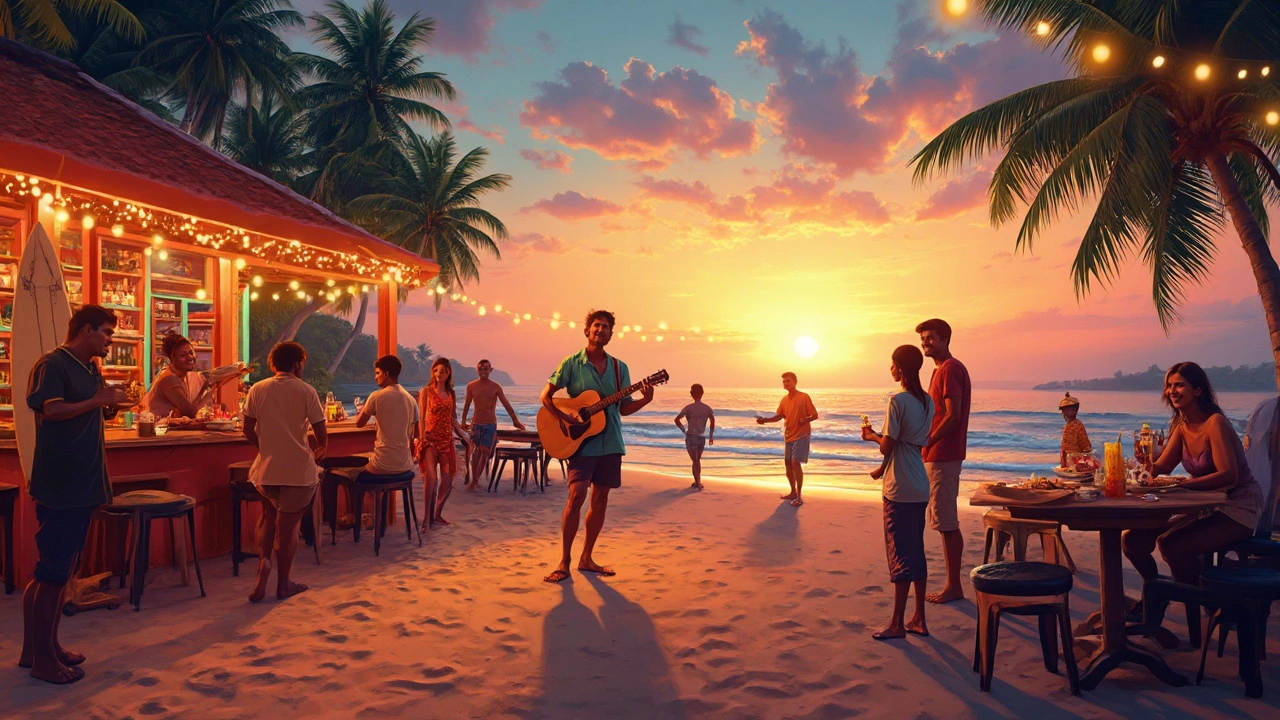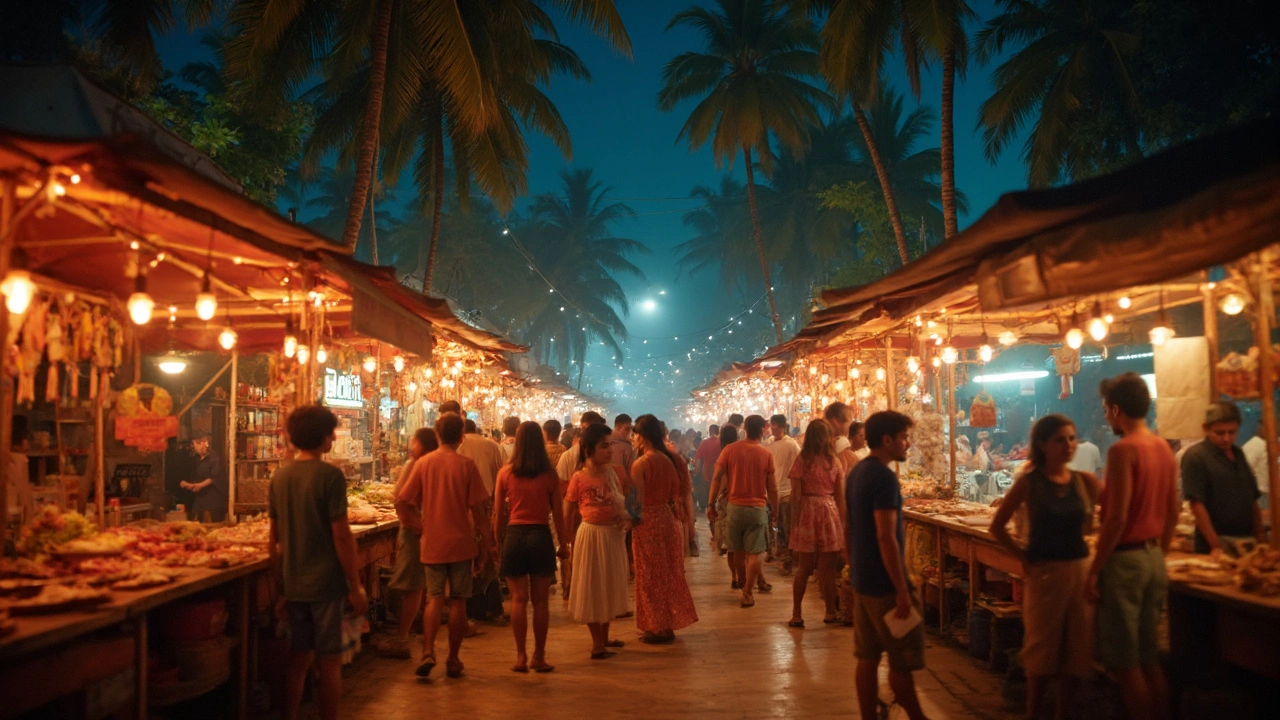Goa Beach Destinations: Why Tourists Keep Coming Back
 Jun, 9 2025
Jun, 9 2025
Goa isn’t your average beach spot. Imagine a place where you can spend the morning learning to surf, grab a plate of spicy prawn curry in a tiny shack, wander a flea market crowded with locals and artists, and still have energy left for a sunset party on the sand. That’s pretty much a regular Tuesday in Goa.
People show up for the beaches, but they come back for that easy-going, ‘do what you like’ vibe. Whether you’re the type who wants to crash in a bamboo hut or stay in a luxury villa with a pool, there’s a place here for every mood and budget. It’s easy to strike up a chat with strangers, share travel tips, or just kick back without anyone bugging you.
Don’t be surprised if you run into yoga lovers from Berlin, backpackers from Argentina, or big groups of friends from Mumbai, all in the same shack ordering Goan fish thali. It’s that kind of place—people from everywhere, all drawn by something different, but usually leaving with the same feeling: Goa lets you be yourself.
- Life on the Beaches
- Food, Nightlife, and Parties
- Culture and Adventure Beyond the Shore
- Must-Know Tips for Visiting Goa
Life on the Beaches
Goa's coastline stretches for about 105 kilometers, which means you’re never far from a different kind of beach scene. Each beach has its own thing going. For instance, Baga and Calangute are always buzzing with crowds, jet skis, and noisy beach bars. If you just want that classic beach holiday feeling, this is it. But if you feel more chill, beaches like Palolem and Agonda in South Goa are the spots for peace, hammocks, and the odd sunset drum circle.
If you’re into water sports, you’ve got options. The main beaches offer banana boat rides, wakeboarding, windsurfing, and parasailing. Operators usually have rates posted right on the beach, and bargaining is almost expected. Here’s a quick look at some popular activities and their average prices:
| Activity | Average Price (INR) | Popular Beaches |
|---|---|---|
| Jet Ski | 500-800 | Baga, Calangute, Candolim |
| Parasailing | 800-1,200 | Anjuna, Baga, Colva |
| Banana Boat Ride | 300-500 | Baga, Palolem |
| Dolphin Watching | 400-600 | SinQuerim, Palolem |
The best time to hang out on Goa’s beaches is between November and February. The weather hits a sweet spot: sunny, not too hot, barely any rain. If you come in the summer or during the monsoon, you’ll see almost zero tourists, big waves, and most beach shacks closed for the season.
With Goa being such a top pick, beach safety gets plenty of attention. Lifeguards work all the main spots, but people still get reckless on the water (especially after a couple of drinks). The safest bet? Swim between the red and yellow flags, avoid swimming at night, and never turn your back on a crashing wave. Tourists get surprised, but fines for drinking directly on the beach are a thing now, too—local police actually do routine checks.
- Most beach shacks open only from October to April
- Dogs are everywhere on the sand—local strays and pets blend right in
- Weekends get packed, especially around Christmas and New Year
- Early mornings are perfect for a quiet run or yoga, before crowds show up
Whether you’re a sun-chaser, party-lover, or family on vacation, Goa’s beaches cover pretty much all the bases. Just don’t forget your sunscreen—the sun in Goa can burn faster than you’d think.
Food, Nightlife, and Parties
If you’re in Goa and not planning your days around food and parties, you’re missing out on half the fun. The food is way more than just seafood (though you’ll definitely want to try the fresh kingfish and fiery Goan prawn curry). Beach shacks dish out everything from crispy calamari to chicken cafreal, and you can grab a thali—rice, bread, veggies, and fish—for under 300 rupees at most local joints.
There’s no single "Goan cuisine"—you get influences from Portugal, Maharashtra, and even the Middle East. That means classics like Goa sausage pao (think spicy pork in a soft bun), beef croquettes, and sweet bebinca for dessert. Vegan or veggie? Plenty of places now do killer plant-based versions of top dishes.
The party scene is real and has been for decades. Goa is where those legendary trance and electronic music parties kicked off in the ‘90s, and the beachside clubbing never really stopped. Places like Tito’s and Mambo’s in Baga, Curlies on Anjuna Beach, and smaller secret bars pop up every year. Don’t be surprised if you walk past a bar at 3am and still find people grooving. Peak season (December to February) gets wild, especially around New Year and the Sunburn Festival—which pulls in over 100,000 party people from all over the world.
If clubbing isn’t your thing, there are still loads of chilled hangout spots. Look for live music nights, karaoke in Arpora, or old-school karaoke at Cavala. Plenty of younger travelers end up at beach bonfire parties or pop-up DJ gigs right on the sand. It’s all way more casual than most Indian cities, and people generally don’t care how you dress or what you drink—as long as you’re having a good time.
| Popular Nightlife Options | Location | Avg. Entry Cost |
|---|---|---|
| Tito's | Baga | Rs. 1500 (with cover) |
| Curlies Shack | Anjuna | Free to Rs. 1000 |
| Sunburn Festival | Vagator | Rs. 2500+ |
| Cohiba | Sinquerim | Rs. 800-2000 |
Quick tip: Drinks are cheaper in Goa than pretty much anywhere else in India, so set a limit before you start ordering fancy cocktails. And always check if there’s a cover charge for parties or clubs—prices shoot up in peak season, especially in hotspots like Baga and Anjuna.

Culture and Adventure Beyond the Shore
Let’s get one thing straight: Goa is way more than just beaches. Sure, the coastline is awesome, but if you ignore everything inland, you're missing half the fun. Goa used to be ruled by the Portuguese for 450 years, so you still see old whitewashed churches like Basilica of Bom Jesus and Se Cathedral tucked between palm trees. The Fontainhas Latin Quarter in Panjim feels like stepping into another country—cobbled lanes, colorful houses, tiny bakeries selling fresh poi bread.
If you’re into history, swing by the old forts. Chapora Fort is the one from the Bollywood flick “Dil Chahta Hai”—the sunset views are worth the uphill walk, and you’ll always find groups trying to recreate famous movie scenes there. Aguada Fort is also cool for quick tours and Instagram shots.
Looking for adventure that doesn’t involve a towel and sunscreen? No problem. South Goa’s forests hide Dudhsagar Falls, which thunders down 310 meters—locals say it’s at its wildest right after the monsoon. If you love hiking, try the trails in Mollem National Park, where you might spot monkeys, rare birds, and if you're lucky, the elusive black panther.
Loads of travelers sign up for water sports. Here’s what’s popular:
- Parasailing at Calangute, for killer views of the coast
- Jet skiing and banana boat rides on Baga beach
- Kite surfing lessons in Morjim (best between October and May)
- Scuba diving trips to Grande Island—expect coral, shipwrecks, and lots of curious fish
If you’re into culture, check out one of Goa’s noisy, colorful festivals. Carnival (usually in February) means float parades, street dances, and free music shows. Shigmo, the Goan version of Holi, is all about bright colours, parades, and traditional dances.
Check this table for quick facts if you're planning non-beach activities:
| Activity | Where | Best Season | Average Cost (2025) |
|---|---|---|---|
| Scuba Diving | Grande Island | Nov - Mar | ₹4000 - ₹6000 |
| Dudhsagar Trek | Mollem | Jul - Dec | ₹2000 - ₹2500 |
| Parasailing | Calangute Beach | Oct - May | ₹800 - ₹1200 |
| Carnival Parade | Panjim/Vasco | Feb | Free |
| Fontainhas Walk | Panjim | Year-round | Free - ₹1000 (guided) |
The crowd starts picking up in October and stays thick until March, so if you like things quiet, hit up the cultural spots early. For the best of everything, talk to local guides. Most know shortcuts, cool events, or hidden food joints that never get written up in typical travel blogs.
Must-Know Tips for Visiting Goa
Goa’s charm can also trip up first-timers who don’t know what to expect. Before you hit the beach or that buzzing shack, keep a few things in mind so you don’t end up in a jam (or paying double for a cab ride).
- Goa has two faces: North and South. North is all about parties, cheap beach huts, and markets. South is quieter, perfect for families or anyone who wants to chill.
- Getting around is way easier with a scooter. Just make sure you have an international driver’s license. Police checks are common and fines aren’t cheap.
- Peak season is November to February. Hotels jump in price, so book early. If you prefer fewer crowds but still want decent weather, late October and early March are solid bets.
- Don’t drink or party on the beach after dark. Cops do random checks and fines can sting.
- Goan food is spicy and heavy on seafood. If you’re allergic or vegetarian, mention it upfront. Beach shacks have plenty of options, but always double check what goes in your curry.
- Cash is king in shacks and markets, though most hotels and bigger restaurants take cards. ATMs run out of cash during rush periods—just ask any local.
- Always ask for the taxi fare upfront. Goa doesn’t have Uber or Ola everywhere, and rates can be pretty random, especially at night.
- Respect the local culture; dress modestly away from the beach. Temples, churches, and markets expect it, and you’ll get friendlier vibes from locals.
If you’re the planning type, this table might save you some last-minute stress:
| Best Time to Visit | Average Hotel Price (per night) | Temperature (°C) | Crowd Factor |
|---|---|---|---|
| Nov–Feb (Peak) | ₹4000+ | 20–32 | High |
| Mar–May | ₹2500–₹3500 | 25–35 | Medium |
| Jun–Sep (Monsoon) | ₹1500–₹2500 | 24–30 | Low |
Last tip: Sunscreen and bug spray are your best friends here. Even if you’re the kind who never burns, Goa’s sun plays by its own rules—and the mozzies? They don’t take holidays.